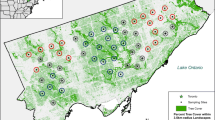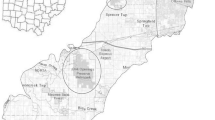Abstract
Despite the clear importance of conserving biodiversity in urbanized areas, research on how bats are influenced by urbanization has is only recently catching up to the more established body of research for urban birds. Much of the extant research has been limited to urban parks and other natural areas. Here I present the results of an acoustic survey of bats throughout the agricultural/forest/suburban/urban mosaic of the Minneapolis-St. Paul metropolitan area. Activity indices by each of the six recorded species (Eptesicus fuscus, Lasiurus cinereus, Lasiurus borealis, Lasionycteris noctivagans, Myotis sp., and Perimyotis subflavus) were used as response variables with land cover variables in a series of statistical models. Because bats may perceive the landscape at different scales, candidate models included land cover variables within 100, 500 and 1,000 m of the sampling location. Activity of L. noctivagans was negatively related to the amount of impervious surface and open habitat in the immediate landscape. L. borealis activity was positively correlated with immediate tree cover and with impervious surface at the 1,000 m scale. Tree cover and proximity to water were positively related to activity levels of Myotis sp., L. cinereus and P. subflavus, but only the latter was influenced by the amount of surrounding impervious surface. These results suggest that a one-size fits all approach to bat conservation in human modified landscapes is not appropriate, but also that certain species appear to do well in urban environments provided that there is sufficient tree cover.

Similar content being viewed by others
References
Aldridge H, Rautenbach IL (1987) Morphology, echolocation, and resource partitioning in insectivorous bats. J Anim Ecol 56:763–778
Avila-Flores R, Fenton MB (2005) Use of spatial features by foraging insectivorous bats in a large urban landscape. J Mammal 86:1193–1204
Baker PJ, Harris S (2007) Urban mammals: what does the future hold? An analysis of the factors affecting patterns of use of residential gardens in Great Britain. Mammal Rev 37:297–315
Benfield FK, Raimi MD, Chen DD (1999) Once there were green fields: how urban sprawl is undermining America’s environment, economy and social fabric. Natural Resources Defense Council, New York
Betts BJ (1998) Roosts used by maternity colonies of silver-haired bats in northeastern Oregon. J Mammal 79:643–650
Blair RB, Johnson EM (2008) Suburban habitats and their role for birds in the urban–rural habitat network: points of local invasion and extinction? Landscape Ecol 23:1157–1169
Britzke ER, Murray KL (2000) A quantitative method for selection of identifiable search-phase calls using the Anabat system. Bat Res News 41:33–36
Campbell LA, Hallett JG, O’Connell MA (1996) Conservation of bats in managed forests: use of roosts by Lasionycteris noctivagans. J Mammal 77:976–984
Carter TC et al (2003) Food habits of seven species of bats in the Allegheny Plateau and Ridge and Valley of West Virginia. Northeast Nat 10:83–88
Clark BS, Leslie DM Jr, Carter TS (1993) Foraging activity of adult female Ozark big-eared bats (Plecotus townsendii ingens) in summer. J Mammal 74:422–427
Coleman JL, Barclay RMR (2011) Urbanization and the abundance and diversity of Prairie bats. Urban Ecosyst Online First 1–16
Coleman JL, Barclay RMR (2011b) Influence of urbanizaiton on demography of little brown bats (Myotis lucifugus) in the prairies of North America. PLoS One 6:e20483
Cryan PM (2003) Seasonal distribution of migratory tree bats (Lasiurus and Lasionycteris) in North America. J Mammal 84:579–593
Czech B, Krausman PR, Devers PK (2000) Economic associations among causes of species endangerment in the United States. BioScience 50:593–601
Duchamp JE, Sparks DW, Whitaker JO (2004) Foraging-habitat selection by bats at an urban–rural interface: comparison between a successful and a less successful species. Can J Zool 82:1157–1164
Duchamp JE et al (2006) Estimating probabilities of detection for bat echolocation calls: an application of the double-observer method. Wildlife Soc B 34:408–412
Elmore LW, Miller DA, Vilella FJ (2004) Selection of diurnal roosts by red bats (Lasiurus borealis) in an intensively managed pine forest in Mississippi. Forest Ecol Manag 199:11–20
Everette AL et al (2001) Bat use of a high-plains urban wildlife refuge. Wildlife Soc B 29:967–973
Fenton MB, Barclay RMR (1980) Myotis lucifugus. Mammal Spec 1–8
Ford WM et al (2005) Relating bat species presence to simple habitat measures in a central Appalachian forest. Biol Conserv 126:528–539
Furlonger CL, Dewar HJ, Fenton MB (1987) Habitat use by foraging insectivorous bats. Can J Zool 65:384–288
Gehrt SD, Chelsvig JE (2003) Bat activity in an urban landscape: patterns at the landscape and microhabitat scale. Ecol Appl 13:939–950
Gehrt SD, Chelsvig JE (2004) Species-specific patterns of bat activity in an urban landscape. Ecol Appl 14:625–635
Hardy PB, Dennis RLH (1999) The impact of urban development on butterflies within a city region. Biodivers Conserv 8:1261–1279
Hostetler M, Holling CS (2000) Detecting the scales at which birds respond to structure in urban landscapes. Urban Ecosyst 4:25–54
Hourigan CL, Catterall CP, Jones D, Rhodes M (2010) The diversity of insectivorous bat assemblages among habitats within a subtropical urban landscape. Austral Ecol 35:849–857
Johnson J, Gates J, Ford W (2008) Distribution and activity of bats at local and landscape scales within a rural–urban gradient. Urban Ecosyst 11:227–242
Jung K, Kalko EKV (2011) Adaptability and vulnerability of high flying Neotropical aerial insectivorous bats to urbanization. Divers Distrib 17:262–274
Knutson MG et al (1999) Effects of landscape composition and wetland fragmentation on frog and toad abundance and species richness in Iowa and Wisconsin, USA. Conserv Biol 13:1437–1446
Kurta A, Teramino JA (1992) Bat community structure in an urban park. Ecography 15:257–261
Limpert DL et al (2007) Tree selection and landscape analysis of eastern red bat day roosts. J Wildl Manage 71:478–486
Lindenmayer D, Hunter M (2010) Some guiding concepts for conservation biology. Conserv Biol 24:1459–1468
Lookingbill TR et al (2010) Influence of wetland networks on bat activity in mixed-use landscapes. Biol Conserv 143:974–983
Lopoukhine N (2008) Protected areas—for life’s sake. In: Janishevski L et al (eds) Protected areas in today’s world: values and benefits for the welfare of the planet. Secretariat of the Convention on Biological Diversity, Montreal, pp 1–3
Marzluff JM (2001) Worldwide urbanization and its effects on birds. In: Marzluff JM, Bowden JL, Donnelly R (eds) Avian ecology and conservation in an urbanizing world. Kluwer Academic Publishers, Boston, pp 19–48
Metropolitan Council (2009) Overview of the Twin Cities region. http://www.metrocouncil.org/about/region.htm. Accessed 18 April 2011
Miller BW (2001) A method for determining relative activity of free flying bats using a new activity index for acoustic monitoring. Acta Chiropterol 3:93–105
Miller JR et al (2009) Prioritizing conservation targets in a rapidly urbanizing landscape. Landsc Urban Plan 93:123–131
Minnesota Department of Natural Resources (2009) Ecological Classification System. http://www.dnr.state.mn.us/ecs/index.html. Accessed 18 April 2011
Nordquest GE, Birney EC (1985) Distribution and status of bats in Minnesota. Final report submitted to the Nongame Wildlife Program, Minnesota Department of Natural Resources. 64 pp
Nordquist GE (2000) Winter use of subterranean cavities by bats in and near Minnesota. Bell Museum of Natural History. University of Minnesota, St. Paul, p 145
O’Hara RB, Kotze DJ (2010) Do not log-transform count data. Method Ecol Evol 1:118–122
O’Farrell MJ et al (1999) Confronting the dogma: a reply. J Mammal 80:297–302
Pecarevic M, Danoff-Burg J, Dunn RR (2010) Biodiversity on Broadway—Enigmatic diversity of the societies of ants (Formicidae) on the streets of New York City. PLoS One 5:e13222
Pennington DN, Hansel J, Blair RB (2008) The conservation value of urban riparian areas for landbirds during spring migration: land cover, scale, and vegetation effects. Biol Conserv 141:1235–1248
Perry RW, Thill RE, Leslie DM (2008) Scale-dependent effects of landscape structure and composition on diurnal roost selection by forest bats. J Wildl Manage 72:913–925
Polasky S et al (2005) Conserving species in a working landscape: land use with biological and economic objectives. Ecol Appl 15:1387–1401
Pruitt L, TeWinkel L (2007) Indiana bat (Myotis sodalis) draft recovery plan: first revision. In: U.S. Fish and Wildlife Service (ed). Fort Snelling, MN, pp. 260
Racey PA, Swift SM (1985) Feeding ecology of Pipistrellus pipistrellus (Chiroptera: Vespertilionidae) during pregnancy and lactation. I. Foraging behavior. Anim Ecol 54:205–215
Richardson B (2004) Minnesota land cover classificaiton system user manual. In: Minnesota Department of Natural Resources (ed). St. Paul, p 273
Rosensweig ML (2003) Win-win ecology: how the earth’s species can survive in the midst of human enterprise. Oxford University Press, New York
Rottenborn SC (1999) Predicting the impacts of urbanization on riparian bird communities. Biol Conserv 88:289–299
Rubbo MJ, Kiesecker JM (2005) Amphibian breeding distribution in an urbanized landscape. Conserv Biol 19:504–511
Russo D, Jones G (2003) Use of foraging habitats by bats in a Mediterranean area determined by acoustic surveys: conservation implications. Ecography 26:197–209
Rydell J (1992) Exploitation of insects around streetlamps by bats in Sweden. Funct Ecol 6:744–750
Tester JN (1995) Minnesota’s natural heritage. University of Minnesota Press, Minneapolis
United States Census Bureau (2003) Statistical abstract of the United States. GPO, Washington, D. C
Weakliem DL (1999) A critique of the Bayesian information criterion for model selection. Sociol Method Res 27:359–397
Wilcove DS, Master LL (2005) How many endangered species are there in the United States? Front Ecol Env 3:414–420
Wund MA (2006) Variation in the echolocation calls of little brown bats (Myotis lucifugus) in response to different habitats. Am Midl Nat 156:99–108
Yates MD, Muzika RM (2006) Effect of forest structure and fragmentation on site occupancy of bat species in Missouri ozark forests. J Wildl Manage 70:1238–1248
Acknowledgements
This work would not have been possible without the financial support and manuscript suggestions provided by my graduate advisor, S. Jansa. Thanks to D. Johnson and C. Mullin for assistance with statistical analysis. C. Corben, M. O’Farrell, and G. Nordquist (MNDNR) provided reference calls which were used as part of the identification library. Special thanks to J. Dixon for being patient with my absence during long nights in the field. Funding for the field component of this project was provided by small grants from the Dayton-Wilkie Natural History Funds of the Bell Museum of Natural History, and support for writing and analysis was provided by a Doctoral Dissertation Fellowship from the University of Minnesota.
Author information
Authors and Affiliations
Corresponding author
Rights and permissions
About this article
Cite this article
Dixon, M.D. Relationship between land cover and insectivorous bat activity in an urban landscape. Urban Ecosyst 15, 683–695 (2012). https://doi.org/10.1007/s11252-011-0219-y
Published:
Issue Date:
DOI: https://doi.org/10.1007/s11252-011-0219-y




